The man who helped save 50 million lives
- Published
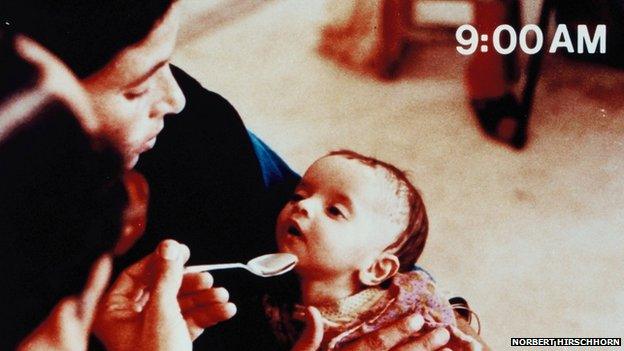
1983: A three-month old Egyptian boy came into a rehydration centre having been been sick with diarrhoea for the past two days; he is obviously dehydrated with sunken eyes and is too weak to even hold his head up

15 minutes into oral rehydration treatment - the boy sips eagerly from the spoon

One hour into treatment he starts getting his strength back
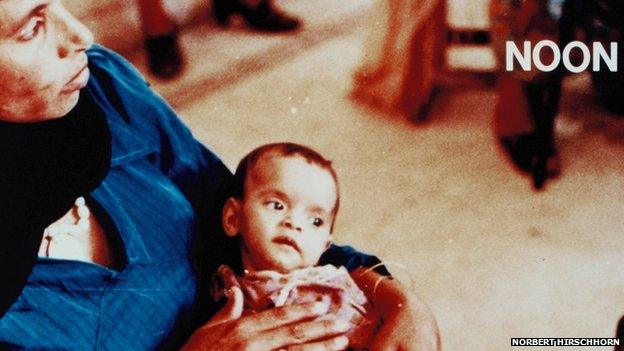
3 hours later he is rehydrated
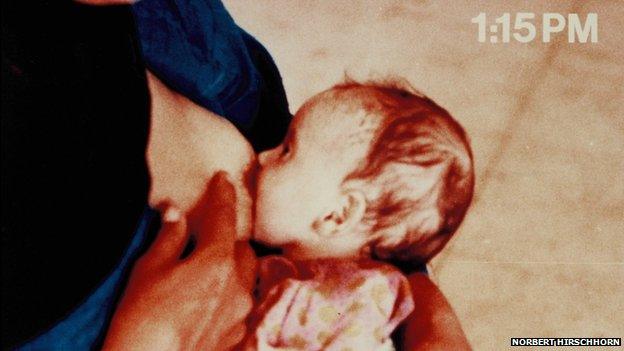
He is even well enough to breastfeed by 1:15pm on the very same day
A solution of sugar, salts and water, many of which can be found in a kitchen cupboard, can be all it takes to save a child's life - and it has saved an estimated 50 million people. But finding the right balance was crucial - and Dr Norbert Hirschhorn played a key part.
After two days suffering from diarrhoea the three-month-old Egyptian boy was too weak even to hold his head up to suckle at his mother's breast.
Doctors feared the worst when he was brought to a rehydration centre in Alexandria: severe diarrhoea is a major killer in the developing world.
But little more than four hours later he was well enough to resume breastfeeding - all thanks to a cheap solution of sugars and salts.
Dr Hirschhorn says the transformation oral rehydration therapy brings is incredible.
"You come into a room and the child - or an adult - is near death. They have sunken eyes. they're breathing very rapidly - their skin and their fingernails are bluish - and in children the soft spot on the top of their head is sunken."
Seeing someone recover from such life-threatening illness is "like seeing Lazarus come back from the dead - a miracle," he says.
Quest for 'balance'
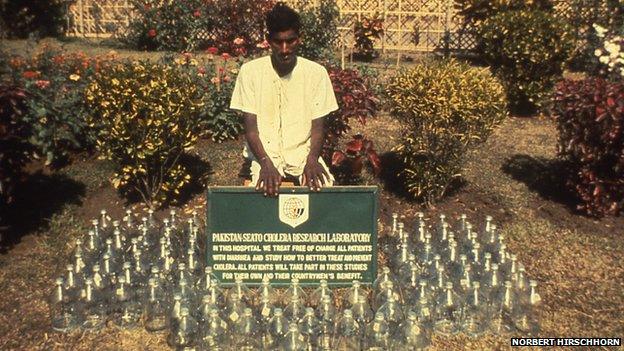
The 100+ bottles represent just how much intravenous fluid this man from Dhaka required over a week-long bout of cholera. The man was purging up to a litre of fluid an hour.
Dr Hirschhorn became involved in the research into oral rehydration therapy in 1964.
He was on military service with the US Public Health Service - and was sent to Bangladesh, then known as East Pakistan, where there was a serious cholera outbreak.
Cholera causes severe diarrhoea, and patients quickly lose too much water and, crucially, salts - and become extremely dehydrated and can go into shock - and can die in just a few hours.
In East Pakistan up to 40% of villagers with untreated cholera were dying.
At the time rehydration treatment was given intravenously in hospital.
It was expensive, and often unavailable to those who needed it most.
So the aim was to find a way of giving the treatment orally - so that many more could be helped.
There had been previous attempts to find the right balance of sugar, salts and water to give in an oral treatment.
Indeed, one of of the people Dr Hirschhorn was working with in East Pakistan - Captain Robert Phillips - had run his own unsuccessful trial some years earlier - in which several patients died.
It meant he was very cautious about letting Dr Hirschhorn run his own research.
"He had tried the solution when he was was with the navy in Taiwan and the Philippines but he got the physiology wrong - it was too concentrated and it made things worse," says Dr Hirschhorn.
He says Dr Phillips was a "military man who ran a tight ship", adding "he really had to trust you to let you do something as outlandish as this trial seemed at the time".
Precautions
"Phillips was very reluctant to let anybody try it again until I was able to show him what had gone wrong with his patients and to show him that if we used a solution that was comparable to blood concentrations of these elements, that we would be fine.
"He would lock the documents up in his office, I had to gain his trust and all precautions had to be taken.
"We had to sleep right alongside the patients; we had to have the emergency intravenous treatment ready to go."
Norbert Hirschhorn on the discovery of Oral Rehydration Therapy
Hirschhorn's work built on both what Dr Phillips had done, and the work of another colleague David Sachar.
Sachar had shown that the body could still transport sodium when glucose was added - something key in fighting dehydration.
Proportions were key - too much or too little of any of the ingredients and not only might the solution not work, but it could also cause severe harm.
Dr Hirschhorn said: "The proof of concept was that they would absorb the fluid and diminish the amount of diarrhoeal fluid coming out.
"The proportions are crucial. In order to get the optimal absorption of water you need the same amount of glucose and sodium.
"Moreover the proportions of electrolytes need to be close enough to the body's own fluid composition so that it can adjust and keep balance."
It was a small study, of just eight patients, external in which the rehydration therapy was given straight into the intestine using naso-gastric tubes - but it proved that specific combination worked.
Hospital - and home
However the introduction of the therapy wasn't simple, even then.
Dr Hirschhorn says there was disbelief something so simply could be so effective and outperform the carefully-dosed, hospital-administered IV therapy
"Its simplicity was its own enemy. But it took a long time; it took a very long time to convince paediatricians that this was safe, to convince them that you could get out there and reach mothers, reach the community directly."
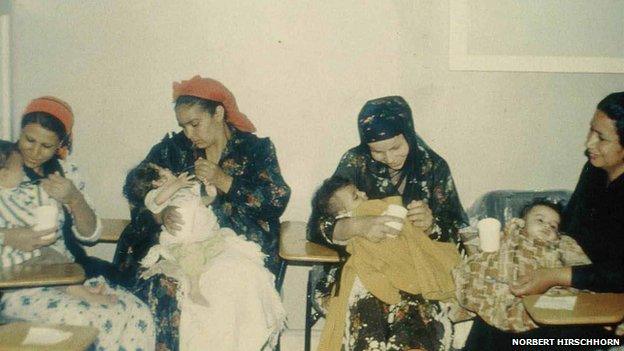
Mothers in Egypt feeding their babies with the rehydration solution
The Lancet has described oral rehydration therapy as "potentially the most important medical advance" of the 20th century with UNICEF adding that no other medical innovation of the century "has had the potential to prevent so many deaths over such a short period of time and at so little cost".
Now the effectiveness is well known and it is used around the world administered by doctors in clinics as well as at home by parents of children.
But the World Health Organization (WHO) warns diarrhoeal disease is the second leading cause of death in children under five, and is responsible for killing around 760 000 children every year.
An Indian charity has set up a rehydration unit in their health centre to ensure local people get access to oral rehydration therapy
And what does it feel like to know that your efforts have led to over 50 million people being saved?
He tells the story of a trip to Egypt, many years after his clinical work.
Travelling in a cab he got chatting to the driver. It turned out the cab driver's own son was saved by oral rehydration when he was a child, and that he was now a young man pursuing his own scientific studies in the USA.
"That exchange" says Hirschhorn, still visibly moved, "made as much of an impact on me as all the statistics".
Dr Norbert Hirschhorn spoke to Claudia Hammond on Health Check. You can listen to or download the latest edition of Health Check from the BBC World Service from Wednesday 6th August at 18:32 GMT.